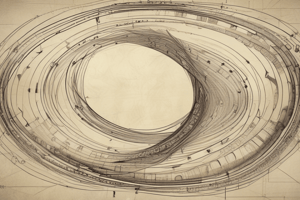Podcast
Questions and Answers
Which of the following is NOT a subset of rational numbers?
Which of the following is NOT a subset of rational numbers?
- Whole numbers
- Irrational numbers (correct)
- Integers
- Natural numbers
What is the defining characteristic of rational numbers?
What is the defining characteristic of rational numbers?
- They include natural numbers, whole numbers, and integers
- They can be represented as both terminating and non-terminating repeating decimals
- They can be expressed as a/b, where a and b are integers and b is not equal to 0 (correct)
- They have a finite decimal expansion
What is the key difference between rational numbers and irrational numbers?
What is the key difference between rational numbers and irrational numbers?
- Rational numbers include integers and fractions, while irrational numbers do not
- Rational numbers can be expressed as a/b, where a and b are integers and b is not equal to 0, while irrational numbers cannot (correct)
- Rational numbers have a finite decimal expansion, while irrational numbers have an infinite non-repeating decimal expansion
- Rational numbers are a subset of irrational numbers
Which of the following is a characteristic of fractions?
Which of the following is a characteristic of fractions?
Which of the following is true about the decimal representation of rational numbers?
Which of the following is true about the decimal representation of rational numbers?
Which of the following is NOT a characteristic of natural numbers?
Which of the following is NOT a characteristic of natural numbers?
What is the key difference between natural numbers and whole numbers?
What is the key difference between natural numbers and whole numbers?
Which of the following is a characteristic of integers?
Which of the following is a characteristic of integers?
Which of the following is an example of an irrational number?
Which of the following is an example of an irrational number?
What is the relationship between rational numbers and irrational numbers?
What is the relationship between rational numbers and irrational numbers?
Which of the following is a true statement about fractions and decimals?
Which of the following is a true statement about fractions and decimals?
Flashcards are hidden until you start studying
Study Notes
The number system is a fundamental concept in mathematics, encompassing various types of numbers used for different purposes. Here is an overview of the number system, covering natural numbers, whole numbers, integers, irrational numbers, rational numbers, fractions, decimals, and their relationships.
Natural Numbers
Natural numbers, also known as counting numbers, consist of positive integers starting from 1. They are used for counting and ordering objects. For example, 1, 2, 3, 4, and so on. However, they exclude 0, fractions, decimals, and negative numbers.
Whole Numbers
Whole numbers are a subset of natural numbers, including 0. They comprise all positive integers and 0. Unlike natural numbers, they allow 0 and have a smaller lower bound. Whole numbers are represented on the right side of the number line and can be subjected to arithmetic operations like addition, subtraction, multiplication, and division.
Integers
Integers include both positive and negative whole numbers, as well as 0. They are defined as the smallest set of numbers containing 0, 1, and every number that can be obtained by adding or subtracting integers. In other words, integers are the set of all natural numbers with their negative counterparts.
Irrational Numbers
Irrational numbers are those that cannot be expressed as a finite or infinite sequence of integers. Examples of irrational numbers include pi, e, and the square roots of non-square integers. These numbers have no finite recurring decimal expansion, making them difficult to deal with mathematically.
Rational Numbers
Rational numbers are a special class of numbers that can be expressed as quotients of two integers, a/b, where a and b are integers and b is not equal to 0. They include integers and fractions. They can be represented as either terminating decimals or non-terminating repeating decimals. Both natural numbers and whole numbers are a subset of rational numbers.
Fractions
Fractions are a representation of parts of a whole. They are a subset of rational numbers and can be expressed as a/b, where a is the numerator and b is the denominator, both being integers.
Decimals
Decimals are a way of representing fractions. They consist of the digit(s) to the right of the decimal point, followed by an infinite sequence that may or may not be repeating. For example, 0.333... is a repeating decimal equivalent to the fraction 1/3.
Studying That Suits You
Use AI to generate personalized quizzes and flashcards to suit your learning preferences.



